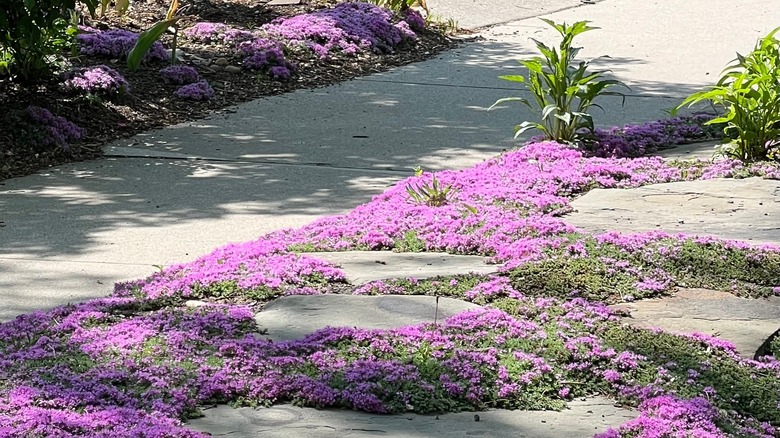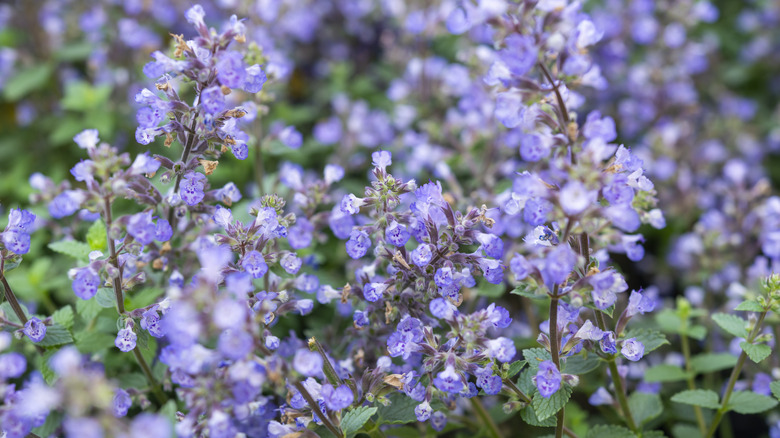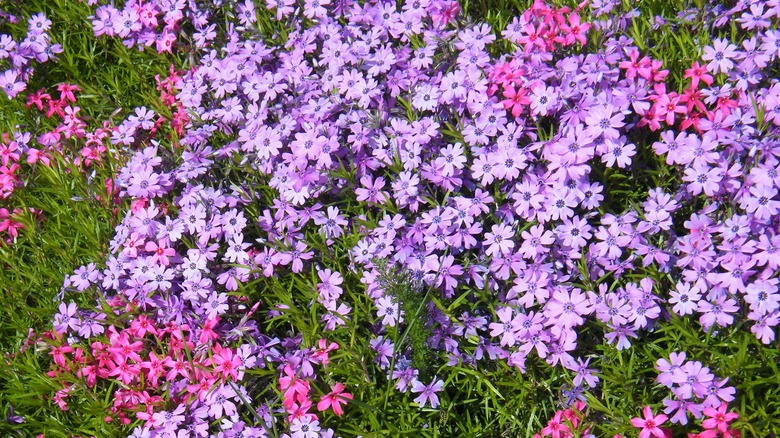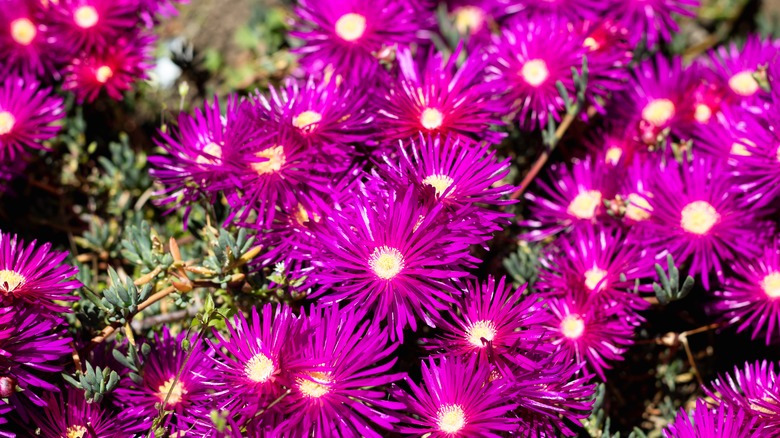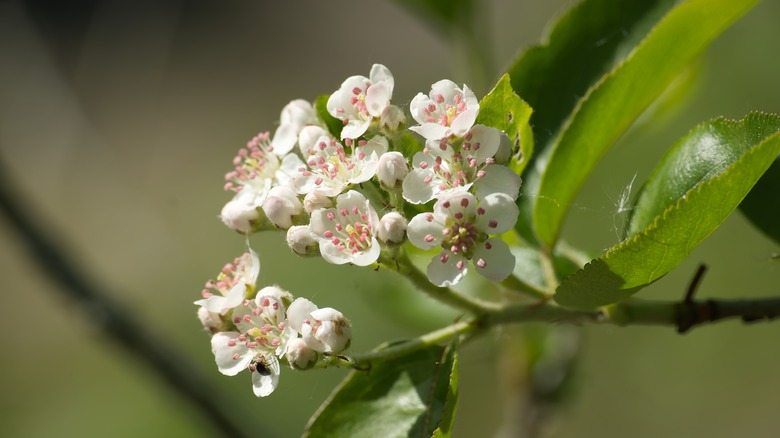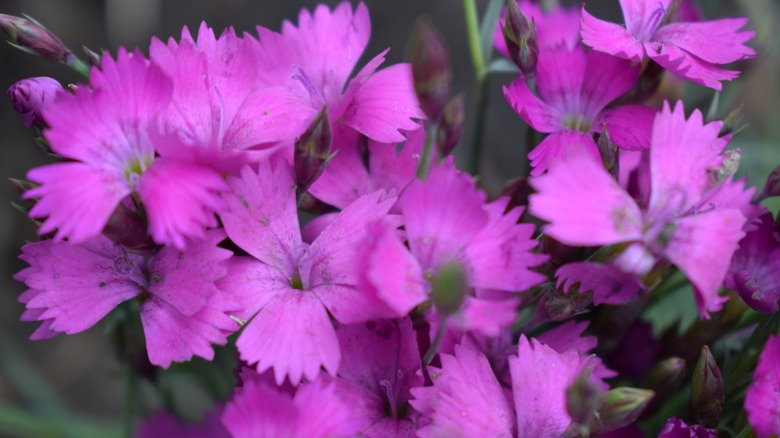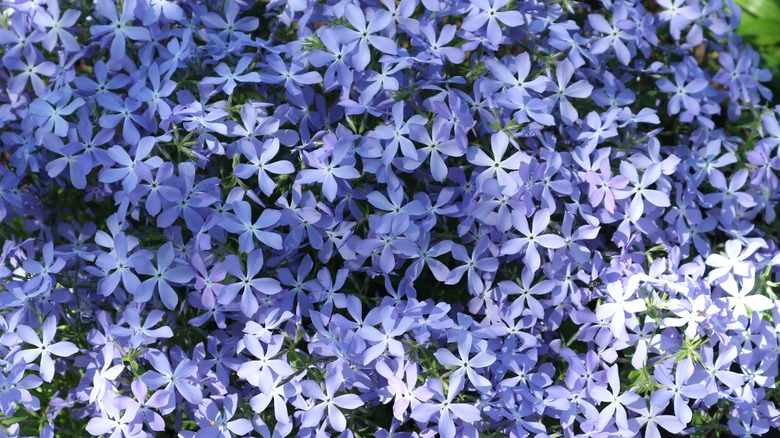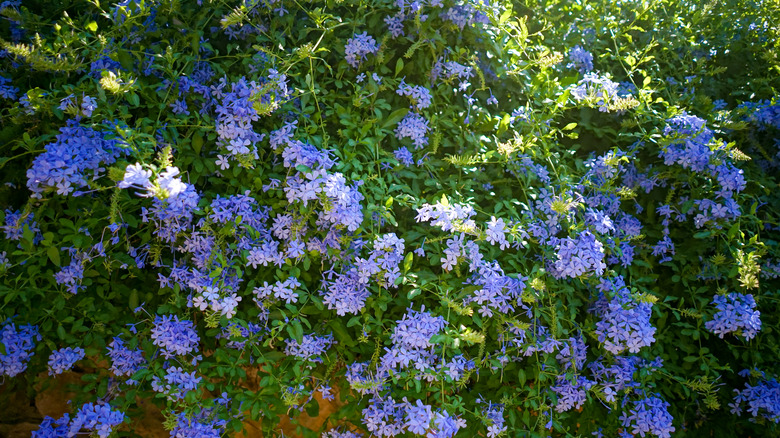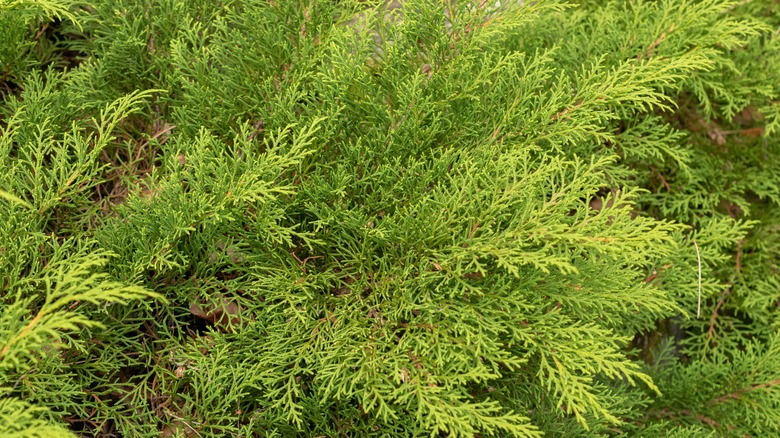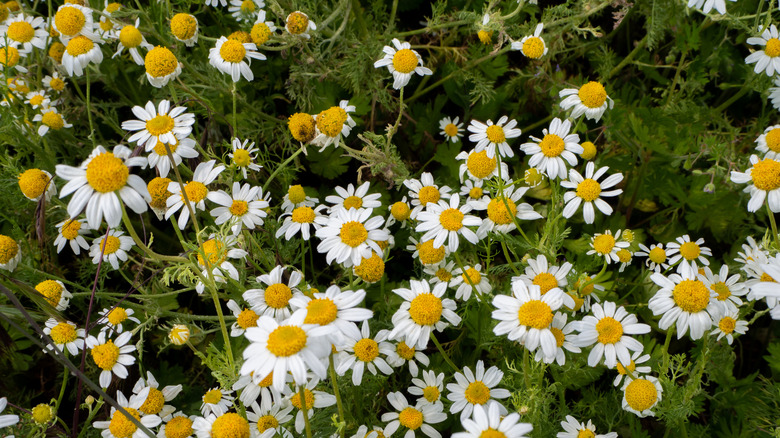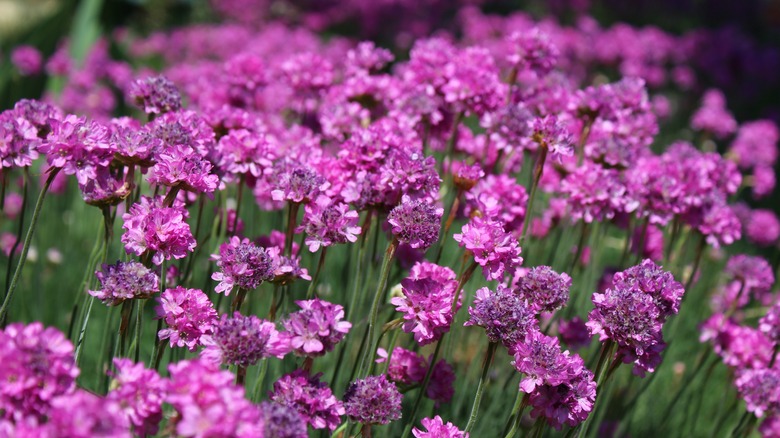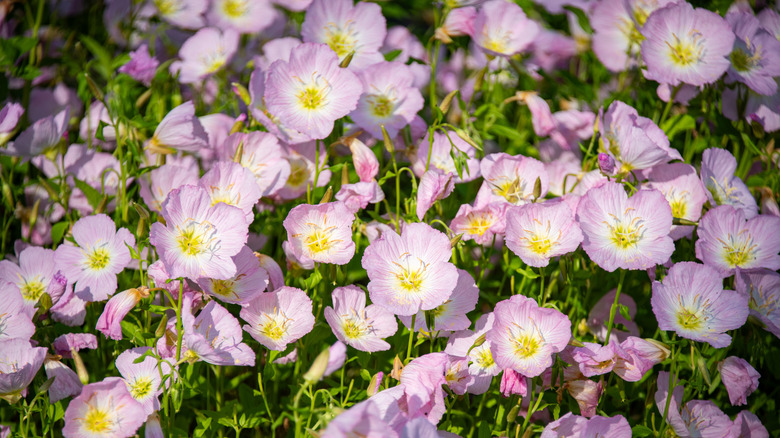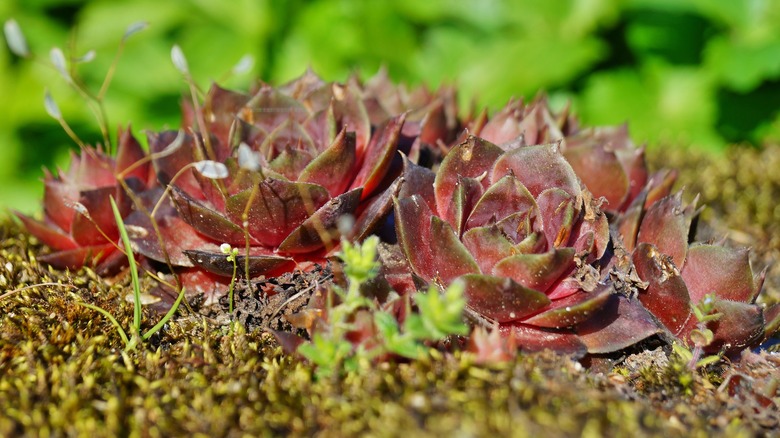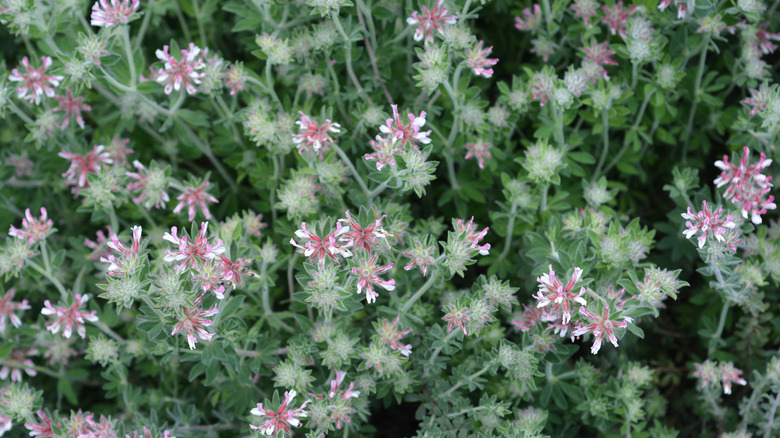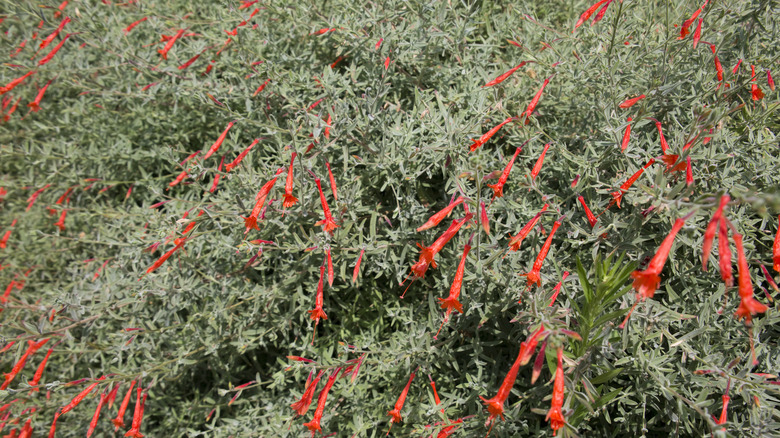16 Ground Covers That Thrive Even In The Harshest Sun
Ground covers can not only greatly enhance the look of your yard or outdoor space, but they also have some incredibly practical benefits. Planting ground covers can help prevent pesky weeds from taking over your garden, protect the soil from erosion, and keep soil temperature cooler. They can also be a very low-maintenance addition to your yard and landscaping. If you live somewhere that receives harsh sun for a large portion of the year, you must choose which ground covers you plant in your yard carefully, as not all will thrive in intense sun. However, many beautiful ground covers, like the hardy ice plant, chokeberry, and chamomile, actually do wonderfully in the sun and can be an excellent addition to your outdoor landscaping.
It's important to keep in mind that even though these ground covers can flourish in harsh sun, they may still need occasional watering to continue to grow. That said, they don't need nearly the same amount of care or watering as typical grass and can still be a great alternative especially if you live in an area that suffers from periods of drought.
Dragon's blood makes a great addition to your rock garden
Looking for a ground cover that is extremely hardy, drought-tolerant, thrives in harsh sunlight, and can be the perfect addition to an outdoor rock garden? You may consider planting Dragon's blood (Sedum spurium) in your outdoor space. This low-growing stonecrop variety is easy to care for and can add brilliant ruby hues to your garden. Dragon's blood is hardy in USDA zones 3 to 9, making it a great ground cover choice for anyone who loves the look of desert plants but may live in a slightly colder climate.
Creeping thyme can make your garden smell amazing
With its vibrant purple flowers, low-growing and sprawling nature, and preference for warm and sunny climates, creeping thyme (Thymus serpyllum) is a great ground cover for sunny regions. While creeping thyme does well in the sun, the best time to plant it is during the cooler spring months so the plant can better establish itself. When first planted, creeping thyme will need regular watering. However, once the plants are established, they'll thrive through periods of drought. Creeping thyme typically grows about 2 to 3 inches tall and has very fragrant leaves.
Persian catmint is a ground cover that repels pests
If your plants and flowers are being devoured by wildlife, Persian catmint (Nepeta racemosa) might be the answer to your problems, as the minty scent of this plant repels deer and rabbits. Like other ground covers, Persian catmint will require more watering when first planted. However, once its roots are established, it's very low maintenance, and the plant will thrive in full sun. Look for the dwarf variety "Blue Wonder" to attract butterflies to your yard.
Creeping phlox thrives in full sunlight
Creeping phlox (Phlox subulata) is another deer-resistant ground cover that grows 6 inches tall and blooms flowers that butterflies absolutely love in late spring. While creeping phlox does thrive in full sun, it's not completely drought-resistant and will still need deep watering weekly. Depending on the variety, creeping phlox can bloom in vibrant shades of pink, lavender, or white. Though it's not considered invasive in the majority of the United States, you should avoid planting this ground cover in parts of Minnesota and Ohio where it's potentially invasive.
Hardy ice plant can handle drought
Not to be confused with other ice plant varieties, which are highly invasive in coastal California, the hardy ice plant (Delosperma cooperi) is a noninvasive, low-growing succulent that blooms with brilliant purple flowers. The hardy ice plant thrives in intense sunlight, needs very little water, is low-maintenance to grow, and is also deer-resistant. It's important to grow the hardy ice plant in an area with good drainage. It also does well on steep slopes.
Chokeberry ground cover can give you fall foliage
As you might have guessed from the name, chokeberries (Aronia melanocarpa) are a ground cover that's excellent for choking weeds out of your garden. Chokeberry blooms with white flowers and has green leaves that transform into lovely burgundy and red hues in fall. Once established, chokeberry is very drought tolerant and prefers moist but never soggy soil. Chokeberry does well with heat and sun but will also tolerate partial shade. If you do plant chokeberry as a ground cover, be prepared for some animal visitors who love to eat its berries.
Pollinators love firewitch
If your outdoor space needs a pop of color, consider planting firewitch (Dianthus gratianopolitanus). In the spring, this ground cover explodes with bright red, purple, or pink flowers. This vibrant plant loves both full and partial sun, but it will need to be watered during extended periods of drought. While this lovely ground cover is popular with pollinators, its leaves are mildly toxic to humans, cats, dogs, and horses. Avoid planting Deptford pink (Dianthus armeria) and maiden pink (Dianthus deltoides) dianthus varieties, which are both considered invasive.
Blue star creeper is a lovely grass alternative
Blue star creeper (Isotoma fluviatilis) is a fast-growing ground cover that can withstand heavy foot traffic and provide your garden with lovely blue flowers in the summer. This ground cover is also happy in full sunlight, although it will need more watering during particularly hot and dry months. Because the blue star creeper does spread so quickly, you should keep it contained and away from your garden and other plants, which you can do with landscape edging. Its resiliency to foot traffic, rabbits, and deer make it a great grass alternative.
Plumbago is a fast-growing ground cover
If you need ground covers that can spread quickly to fill in your outdoor space, plumbago (Ceratostigma plumbaginoides) might be just what you're looking for. This sun-tolerant ground cover has pretty blue and white flowers and thrives in dry soil and hotter climates. While plumbago is not considered invasive, it spreads very aggressively. You will want to keep it separated from your other plants so it doesn't take over. While working with plumbago, be sure to wear gardening gloves because this plant can cause a mild skin reaction.
Siberian cypress can handle harsh summers and winters
Despite its reputation as a wintery plant, Siberian cypress (Microbiota decussata) also thrives in full sun, making it a good ground cover option for anyone who lives in a climate that experiences both intensely hot summers and harsh winters. This evergreen shrubby plant grows slowly, so it's safe to put it close to your other plants and garden. Siberian cypress is also deer-resistant. Though it can handle the sun, occasionally water Siberian cypress during particularly long summer droughts to keep it happy.
Chamomile is a fragrant ground cover
You heard correctly— chamomile (Matricaria recutita) isn't just a cozy bedtime tea. It can also replace your grass and function as an excellent ground cover, even if you live somewhere with harsh sun. To grow chamomile ground covers, place plants close together, about 4 to 8 inches apart, and avoid walking on them the first few months. Once the plants are more established, you can walk on them, but it's best to limit foot traffic. When you occasionally step on chamomile, it releases a delicious smell, and the plants will also attract pollinators.
Sea thrift will complement your coastal garden
Sea thrift (Armeria maritima) is very happy with full sun and dry soil and is a great choice for a ground cover if you're striving to create a lovely coastal aesthetic in your yard or garden. This shrubby evergreen plant grows in a tuft with spiky leaves up to 1 foot tall, and during the springtime, it shoots off taller pink, white, and lavender flowers. This plant spreads a little slower than most other ground covers, so it works well as a border or a ground cover in a rock garden.
Mexican evening primrose can handle the driest climates
Mexican evening primrose (Oenothera speciosa) originates from Texas, Mexico, and New Mexico, so it's no surprise that this ground cover flourishes under the hot sun with dry soil. Because this plant spreads extremely quickly, it does well as a ground cover and has beautiful, fragrant flowers. However, it can spread somewhat aggressively, so this is not the best ground cover option if you have a nearby garden you don't want to become overgrown.
Hens and chicks create a densely matted ground cover
The hens and chicks (Sempervivum hybridum) is a succulent that creates a wonderfully dense and matted ground cover. Like other succulent ground covers, hens and chicks do well in desert climates with harsh sun, dry soil, and very little water. They're also very easy to plant and grow if you're a beginner plant parent. Hens and chicks spread very quickly; in fact, their nickname comes from the little offsets the plant puts off, as they resemble chicks spreading around the hen (the original plant).
Hairy canary clover repels deer but attracts bees
The hairy canary clover (Dorycnium hirsutum) is a shrubby ground cover that shoots off white and pink flowers that resemble clovers. Originating from Portugal, this plant is extremely tough and resilient to harsh sun and drought. If you do utilize this evergreen ground cover in your garden, make sure it has well-draining soil, as the plant can be susceptible to root rot. Its fuzzy leaves and stems will repel deer and rabbits, but bees do love to visit and pollinate the hairy canary clover.
California fuschia attracts hummingbird species
If you're looking for a ground cover that will attract hummingbirds to your garden, the trumpet-shaped red flowers of California fuchsia (Epilobium canum) should do the trick! Thanks to its drought-resistant and low-growing qualities, California fuchsia works fabulously as a ground cover if you live in a dry area. It's perfect for planting in any drab parts of your yard or garden you're looking to spruce up with some color during the summer and fall without having to dedicate too much water to the area.


